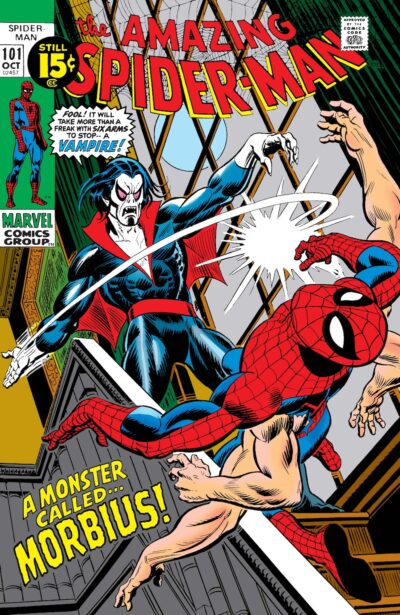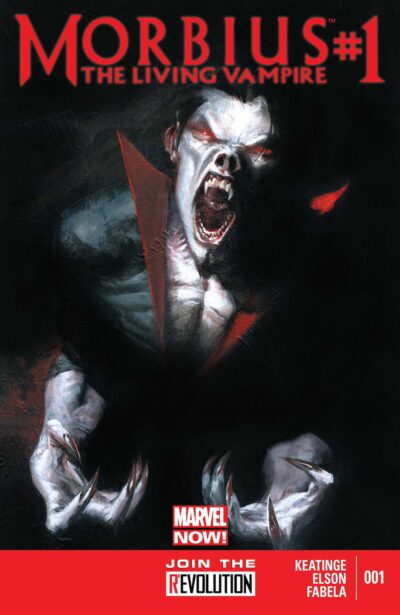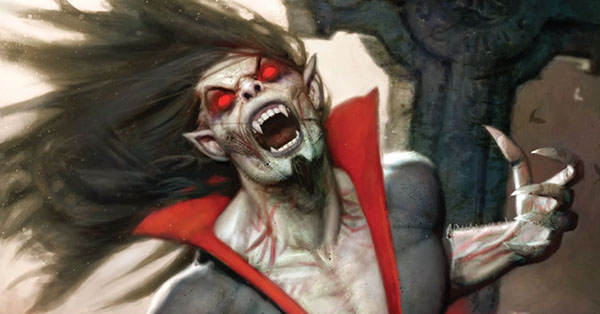I’m back with the first new guide of February 2024 for all Patrons of Crushing Krisis – and it’s their January Patron’s Choice! It’s a guide for one of the horrific stars of 1970s Marvel, of the first Marvel characters to anchor two titles at the same time, and the most alive vampire you’ll ever meet. That’s right, folks, it’s Morbin’ time, with my Guide to Morbius – The Living Vampire.
Guide to Morbius – The Living Vampire
Morbius is one of those characters who I had next to zero exposure to prior to beginning my Marvel Zombie “read everything” approach to comics in 2011. That meant I had two seemingly conflicting ideas of the character in my mind – that he was a major Spider-Man villain and probably had been in the Sinister Six and that he was some sort of supernatural hero who was an ally of Ghost Rider.
Now that I’ve read every single Morbius appearance to write this Guide to Morbius, I know both those ideas were completely wrong! A better way to describe him would be as a reluctant monster and a begrudging anti-supernatural avenger, but even that fails to fully capture the nuance of his character… at least, when writers remember that he has nuance!
 Who is the real Dr. Michael Morbius? He is an occasional Spider-Man villain, though he’s also been an ally. And, he’s a totally non-supernatural vampire who lives and breathes just like your or me.
Who is the real Dr. Michael Morbius? He is an occasional Spider-Man villain, though he’s also been an ally. And, he’s a totally non-supernatural vampire who lives and breathes just like your or me.
He’s also a character stuck in an endless loop of repeating status quo after he had a unique and satisfyingly complete character arc from 1971 to 1981.
When he debuted in Amazing Spider-Man (1963) #101, Morbius was yet another animal-inspired super-scientist Spider-Man villain. Yet, two things made him special from the moment of his debut.
First, he debuted in the first issue of Amazing Spider-Man not written by Stan Lee! Instead, the issue was written by Roy Thomas – who created Morbius along with artist Gil Kane.
Second, the reason Morbius was created – and why he figured so prominently on the cover of his debut issue – was the Comic Code Authority. Or, more accurately, because the Comic Code Authority had relaxed their rules about supernatural characters like vampires appearing in comic books at the start of 1971. Marvel still hedged their bets, making Morbius a man who infused his DNA with that of vampire bats to cure a rare blood affliction, but backstory and beating heart aside their character was clearly a vampire.
Morbius flourished in the early 1970s thanks to the relaxed code, a surge of interest in horror characters, and Marvel’s foray into black-and-white magazine publishing. That’s what led to him anchoring two ongoing titles at the same time! He quickly graduated from the pages of Spider-Man to become the main feature in Vampire Tales [Magazine] 1973 as Marvel’s most-recognizable pseudo-vampire. However, he also took over [Adventures Into] Fear (1972) with issue #20 when Man-Thing was promoted into his own title.
Reading these early Morbius stories today is a wild experience, especially with how they alternate in continuity order (as reflected in Epic Collections Volume 1-2). In Vampire Tales, Morbius is a throat-slashing savage monster in black-and-white stories full of gore and buxom women. In Fear, he is sucked into a colorful mega-arc where he chases his former lover and fights against The Caretakers.
Despite the different production and tone of the two comics, they established a specific character for Michael Morbius. He wasn’t exactly trying to resist his savage, blood-sucking nature – but, he did regret it. He was hopelessly enamoured with any woman who might be slightly led astray or taken advantage of (as long as he could resist draining her blood). And, as a monster of science, he viewed it as his unspoken duty to root out actual supernatural evil and those who worshipped it.![Morbius on the cover of Vampire Tales [Magazine] (1973) #10, as covered by my Guide to Morbius - The Living Vampire.](https://www.crushingkrisis.com/assets/Vampire_Tales_1973_0010-400x541.jpeg)
Those traits made for an exciting and highly-readable pair of dueling adventures that find Morbius criss-crossing the United States. However, the end abruptly in 1975 as the early-70s horror craze cools. Suddenly, Morbius was without a comic! He made just four appearances in the latter half of the 70s, though one was the key creation of the “Legion of Monsters” – then a scary supergroup of Morbius, Werewolf by Night, Ghost Rider, and Man-Thing.
One positive quality of the Marvel Bullpen of the 70s and 80s is that all of the writers were familiar with the whole line and they loved to pick up dropped stories from each other. That was the case when David Anthony Kraft adopted Morbius into his run on Savage She-Hulk (1980). Perhaps sensing Morbius had run his course after a pair of outings with him back to being a basic Spider-Man villain, Kraft wrote the climax of Morbius’s story as he was brought to trial for his many murders. It makes for a compelling story that is surprisingly important to She-Hulk’s early character development and the plot of her series.
After his She-Hulk appearances, Morbius was just a regular doctor atoning for his past crimes… which didn’t make for very exciting comics. It was inevitable that eventually Morbius would go bad once again.
As more violent comics and scarier characters started to come back into vogue in the late 80s, his creator Roy Thomas took the opportunity to explore his vampiric roots in the pages of Doctor Strange, Sorcerer Supreme. On the heels of that appearance, Marvel launched Morbius into his own solo ongoing title in 1992 as part of the Midnight Sons line centered on the mega-popular Ghost Rider.
Morbius proved to be the Midnight Sons book with the most staying power, running for 32 issues and outlasting a second Ghost Rider Series, Blade vehicle Nightstalkers, and a Darkhold series. This gave writers Len Kaminski, Greg Wright, & Lisa Trusiani time to develop Morbius as a hero with a life and an extended cast in a way he never enjoyed in the 1970s. Yet, the close ties to Ghost Rider and other horror heroes meant that his character never developed as much as he did in his original arc through 1981. Every time he slightly changed there was a reversion to something scary.
There’s not much to say about Morbius’s comic appearances from the end of that series in 1995 through the 2000s until he was recruited for Marvel Zombies 3 (2008). It makes a weird kind of sense that Marvel’s living, deathless vampire would be the centerpiece of a series focusing on a rampage of extra-dimensional living dead. It brought something new to Morbius: a comedic tone that made a surprising amount of sense for the character. Now, his mad-science origins were re-cast as high camp, in the same way many 1970s pulp fiction films were now viewed as camp classics.
That lead to him anchoring Marvel Zombies 4 in a reformed Legion of Monsters, who were then picked up by Rick Remender for his very odd “Franken-Castle” run of Punisher. Punisher was Morbius’s Monster in this run, as Morbius played Frankenstein to Frank Castle’s fresh corpse. Afterward, he spun into yet another silly series with Legion of Monsters (2011).
This was around the time I became aware of Morbius. It’s hard for me to say if I love his subsequent Morbius: The Living Vampire (2013) series purely out of nostalgia for the start of Marvel Now or because it was actually great.
However, now having read all of his appearances for this Guide to Morbius, I think there’s actually a third reason I loved this short-lived Joe Keatinge series: it’s a unique take on the character. Morbius was cast as a plainclothes defender of a specific Brooklyn neighborhood while trying to stay out of the eyes of the law. That gave him both a reason to restrain his murderous urges as well as the outlet to get incredibly violent with anyone who threatened his new community.
Since then, Morbius has been adrift. He was purely a gag character for half a decade, existing only as a punchline (usually in Deadpool comics). Then, he returned for some guest-starring turns, and garnered another series that was cut short by the pandemic (and also by just not being very good).
Ultimately, I think Morbius is a character who requires the kind of specificity of his Marvel Zombies comedy or Keatinge’s neighborhood defender, because the full tragic arc of his origins already played out perfectly in the 1970s. He has never clicked as a Spider-Man villain for more than an issue or two because he has no sinister master plan – past his hunger, his motivations tend to be neutral or even altruistic. And, he will always be a strange outlier in the world of supernatural horror due to his scientific origins.
I think there are ways to pitch a long-running Morbius comic that thread the needle between those past stories and failed plots, but with him as the butt of silly internet memes after his flop 2022 film I suspect we’ll see more of the comedy route in the future.
Want instant access to this Guide to Morbius – The Living Vampire? Become a Patron of CK for as little as $2 a month or $20.40 a year to gain access to this exclusive guide and over 70 other guides months before the general public gains access to them. I have launched 39 Guides to Patrons in the past 365 days – 16 Marvel, 3 DC, & 20 Indie/Licensed! Plus, I’ve also updated over 100 of my 200+ guides for both patrons and the general public.
Exclusives for Crushing Cadets ($1/month): 51 Guides!
DC Guides (7): Batman – Index of Ongoing Titles, Batman: Legends of the Dark Knight, Birds of Prey, Green Lantern Corps, Green Lantern: Hal Jordan, Green Lantern: Kyle Rayner, Omega Men
Marvel Guides (31): Alpha Flight, Angela, Beta Ray Bill, Black Cat, Blade, Captain Britain, Dazzler, Domino, Dracula, Echo, Elsa Bloodstone, Emma Frost – White Queen, Heroes For Hire, Legion, Marvel 2099, Marvel Era: Marvel Legacy, Mister Sinister, Monica Rambeau – Photon, Morbius, Rocket Raccoon, Sabretooth, Silk, Spider-Ham, Spider-Man 2099, Thunderstrike, Valkyrie, Vision, Weapon X, Werewolf by Night, What If?, X-Man – Nate Grey
Indie & Licensed Comics (13): Aliens, The Authority, Black Hammer, Brigade, Codename Strykeforce, Cyberforce, Pitt, Princeless & Raven The Pirate Princess, Savage Dragon, ShadowHawk, Stormwatch, Supreme, WildStorm Events
Exclusives For Pledgeonauts ($1.99+/month): 86 Guides!
All of the 51 guides above, plus 35 more…
DC Guides (17): Animal Man, Aquaman, Books of Magic, Catwoman, Doctor Fate, Flash, Harley Quinn, Houses & Horrors, Infinity Inc., Justice League, Justice Society of America, Mister Miracle, Nightwing, Outsiders, Suicide Squad, Superman in Action Comics (1938 – 1986), Swamp Thing
Marvel Guides (13): Darkhawk, Falcon, Gwenpool, Hellcat – Patsy Walker, Howard the Duck, Kang the Conqueror, Loki, Power Pack, Red She-Hulk, Sentry, Spider-Gwen, Spider-Man: Miles Morales, Venom
Indie & Licensed Comics (5): Miracleman, ROM – Spaceknight, Teenage Mutant Ninja Turtles – IDW Continuity, Teenage Mutant Ninja Turtles – Mirage Studios Continuity, ThunderCats

Leave a Reply